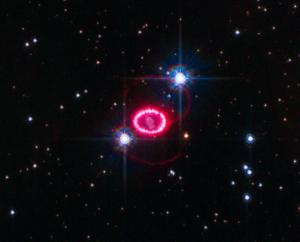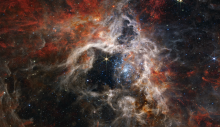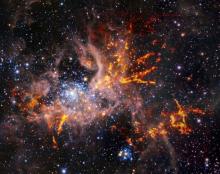This 2010 Hubble Space Telescope image shows the aftermath of Supernova 1987a, which was discovered in February 1987. It was the brightest supernova visible from Earth in almost four centuries. In this view, a shockwave from the exploding star is heating a blobby ring of material around the star, making it look like a pearl necklace. The ring was expelled into space by the star about 20,000 years before the supernova blast. The supernova formed when a supermassive star exploded in the Large Magellanic Cloud, a companion galaxy to the Milky Way. [NASA/ESA/K. France (Univ. Colorado, Boulder)/ P. Challis and R. Kirshner (CfA)]
You are here
Supernova 1987a
Supernova 1987a is a gift that keeps on giving. The exploding star was discovered 35 years ago this week. In the decades since, it’s revealed a lot about many topics: the stars that become supernovas, the processes that drive the explosion, the mechanism that keeps them bright for a long time, and more.
Supernova 1987a was in a galaxy that’s more than 160,000 light-years away. Even so, the explosion was bright enough to see with the unaided eye.
Pictures taken before the blast revealed that the exploding star was a blue supergiant. Until then, astronomers thought such stars would have to expand and cool to become red supergiants before they could explode.
Shortly before the supernova became visible, detectors recorded a small outburst of neutrinos. These ghostly particles rarely interact with other matter. But theory says a supernova should produce huge numbers of them, providing much of the power for the explosion. The neutrino discovery confirmed that idea.
Supernova 1987a remained quite bright for many years, mainly through the decay of radioactive elements forged in the blast — another confirmation that models were on the right track.
The models also said that a supernova should leave behind a neutron star — the star’s crushed core. It took time to find it. But just last year, astronomers confirmed its discovery — one more “gift” from an exploding star.
Script by Damond Benningfield
Get Premium Audio
Listen to today's episode of StarDate on the web the same day it airs in high-quality streaming audio without any extra ads or announcements. Choose a $8 one-month pass, or listen every day for a year for just $30.







